
Place yourself in a four hundred year old city located in the centre of Cuba. Add such details as narrow cobblestoned streets, wide wooden doors, large windows, fountains in central courtyards, decorative railings, and brick red tiles, all lending a colonial elegance to the mansions and small palaces that majestically stand around you. You won't have any other choice but to say that you are in Trinidad.
 This timeless town, formerly named Santísima Trinidad, was founded in 1514 by Diego Velazquez de Cuellar near the banks of the Guaurabo River and on the hillside of the Escambray Massif.
This timeless town, formerly named Santísima Trinidad, was founded in 1514 by Diego Velazquez de Cuellar near the banks of the Guaurabo River and on the hillside of the Escambray Massif.
Being a UNESCO World Heritage Site since 1988 together with the Valle de San Luis and the Valle de los Ingenios (the "Valley of the Sugar Mills") and with 73 archaeological and industrial sites, Trinidad is one of the most visited towns in Cuba.
According to historical documents, there were 48 sugar mills in the valley in 1840. There are still some excellent examples, like the Gúimaro sugar mill, from that period seen in still standing towers, machinery and mansions. Most of the harvesting was performed by slaves with the number reaching as high as 11,897 in 1827.
One of the most important sites to visit in the valley is the 43.5 metre high tower of the Manaca-Iznaga Sugar Mill. Rising proudly and seemingly impervious to time, it was considered a symbol of the 19th Century and the view of the surrounding landscape from the top is still breathtaking.
 During Trinidad's early days, winter was the best season for visitors. Nights were filled with dancing and parties while during the day, people used to climb to the Loma del Puerto to enjoy the wonderful view of the bay and valley below. The greatest attraction was to ride on horseback or in carriages up to La Vigía or "The Lookout" before lunchtime. For Alicia Garcia Santana, a Cuban researcher, "Trinidad is a very exceptional place. It is undoubtedly one of the most important architectural and urban testimonies of Cuba and Latin America.
During Trinidad's early days, winter was the best season for visitors. Nights were filled with dancing and parties while during the day, people used to climb to the Loma del Puerto to enjoy the wonderful view of the bay and valley below. The greatest attraction was to ride on horseback or in carriages up to La Vigía or "The Lookout" before lunchtime. For Alicia Garcia Santana, a Cuban researcher, "Trinidad is a very exceptional place. It is undoubtedly one of the most important architectural and urban testimonies of Cuba and Latin America.
"Pottery, Weaving, and Embroidery
Pottery constitutes the pride of Trinidad along with weaving and other skills such as embroidery. Yarey or Cuban Palm leaves are used to make traditional farmer's hats. There is a movement to rescue the region's historical traditions and artisanal skills.
A leader of this movement is Teresa Toscano who recently received a UNESCO Seal of Excellence. Nilo Reyes, Director of the provincial branch of the Cuban Cultural Heritage Fund, told CubaPLUS that this was a distinction was granted to ten special Cuban works. Toscano earned this award for her works in linen.
 Using a stitch known as the trinitaria, she created a unique tablecloth with napkins and a table runner, all inspired by handicrafts inherited by the inhabitants of the city.
Using a stitch known as the trinitaria, she created a unique tablecloth with napkins and a table runner, all inspired by handicrafts inherited by the inhabitants of the city.
The Seal of Excellence was presented during the First National Arts and Crafts Fair held last December in Havana with the participation of Aruba, the Dominican Republic, and Haiti.
Hotel Accomodations
There are several different hotel options in the Trinidad area. Beach lovers should try the Brisas Trinidad del Mar, the Hotel Club Ancón, or the more affordable Costa Sur.
In town you will find the Iberostar Grand Hotel Trinidad, the first five-star hotel in the central region of the island. As a special attraction you might want to check out the disco at the Las Cuevas Hotel with its open bar and dance area inside an underground cave system.
Trinidad has developed a tourist center using colonial elements from the 18th and 19th centuries such as balconies, building facades, a clock tower, lamp posts, and cobbled streets to recreate the historical village centre. This is a pleasant place to relax and people watch.
 Topes de Collantes, a mountainous region near Trinidad, is a real haven with its excellent climate and highly varied flora and fauna peculiar to the region. At almost 800 metres above sea level, travelers and hikers will find caves, fast flowing narrow rivers, and waterfalls like the Caburni, a national monument.
Topes de Collantes, a mountainous region near Trinidad, is a real haven with its excellent climate and highly varied flora and fauna peculiar to the region. At almost 800 metres above sea level, travelers and hikers will find caves, fast flowing narrow rivers, and waterfalls like the Caburni, a national monument.
The peaceful and dreamlike environment of Topes, as most locals call the area, includes 15 species of pine trees, 12 of eucalyptus and more than 100 ornamental plants as well as a wide variety of ferns, medicinal plants, wild orchids and butterflies.
Trinidad values its interesting stories of pirates and corsairs and the visits of historical personalities such as the German scientist, Alexander Von Humboldt, considered the second discoverer of Cuba. Other stories are related to the arts, suchas the presence of the Cuban poet Gabriel de la Concepcion Valdés.
 There are also legends such as the one of Caucubu, the most beautiful Indian woman of the Guamuhaya tribe and her eternal love for Naribo. When Naribo found out that Caucubu's father intended to give her away to the local governor, he threw himself onto some rocks to his death. Caucubú went into the Maravillosa Cave and died of love. There is a fountain in this cave in her honour which has special powers of rejuvenation for those who drink from it.
There are also legends such as the one of Caucubu, the most beautiful Indian woman of the Guamuhaya tribe and her eternal love for Naribo. When Naribo found out that Caucubu's father intended to give her away to the local governor, he threw himself onto some rocks to his death. Caucubú went into the Maravillosa Cave and died of love. There is a fountain in this cave in her honour which has special powers of rejuvenation for those who drink from it.
Trinidad's street names poetically reflect religious festivities and the town's own events such as Desengaño (Disappointment), Esperanza (Hope), Gracias (Thanks), Dolores (Sorrow), Olvido (Oblivion) and Amargura (Bitterness ).
Today, Trinidad continues being a daydream for those who tour through its streets, giving the sensation of going back in time, penetrating into the mysteries of its mansions turned into museums, and enjoying its natural beauty, culture and its lovely people.
.